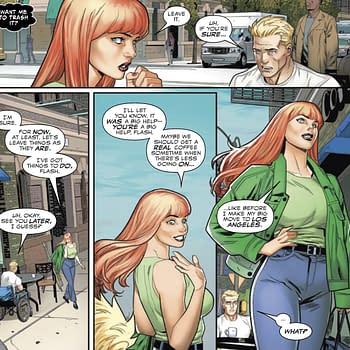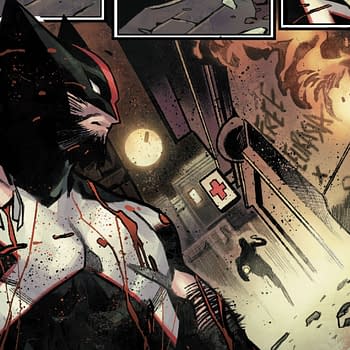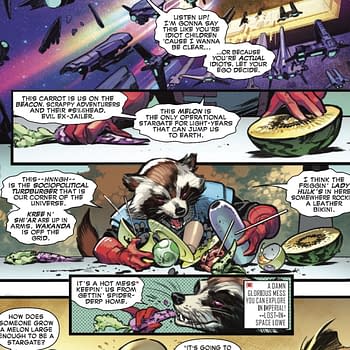Posted in: Comics, Recent Updates | Tagged: brian wood, chuck palahniuk, Comics, comics pro, dark horse, entertainment, Ethan Young, Fight Club 2, Harrow County, hellboy, matt kindt, mike mignola, Nanjing: Burning City, Past Aways, rebels, scott allie, Scott Kolins
Discussions With Scott Allie: The Post Comics PRO Round Up – Fight Club 2, Beer, Rebels, Past Aways, Nanjing: Burning City, Harrow County And More!
Dark Horse caused quite a stir of amusement at the Comics PRO Annual Meeting in Portland in February, as well as making a strong statement about their current and upcoming books, and Editor-in-Chief Scott Allie joins us here today for a tour through the titles that were making the headlines at the show, as well as to give us insights into the creative minds behind upcoming titles. From the severed foam arms, all signed, distributed with the help of Chuck Palahniuk to the Hellboy Beer launched at the retailer event courtesy of Mike Mignola, Dark Horse certainly made the weekend a memorable one for attendees, but we're lucky enough today to take a more leisurely stroll through the books that the publisher is most excited about right now and find out why they capture Scott Allie's imagination.
Some of the creators we'll be talking about are Chuck Palahniuk, Brian Wood, Matt Kindt, and Ethan Young, and some of the titles we'll be discussing include: Fight Club 2, Rebels, Eve: Valkyrie, Mind MGMT, Pistolwhip, 2 Sisters, Past Aways, Two Brothers, Nanjing: Burning City, and Harrow County. Don't worry, we won't overlook the beer or the severed arms along the way.

Scott Allie: If I remember correctly, the Wednesday before Comics PRO started, Ei8ht had just come out and sold out. So that was a nice way to be walking in to Comics PRO with retailers talking about how Ei8ht and Lady Killer #4 had sold out. We were going in with a head of steam and a great feeling about some of our biggest projects like Fight Club 2 as well as some of the more modest creator-owned books that had seen a lot of success. We're on track to deliver a bunch of those over the next few months.

SA: That's all Chuck [Palahniuk]. He comes up with this stuff and he handles everything himself. We offer to help over and over again but he has these ideas and does all the work himself. He had the arms shipped from his place down to the hotel. We received them at the hotel that morning and unpacked them and it was the first time even I'd seen the arms. I had been wondering, "What the hell are these arms going to look like?" They went over pretty big.
HMS: Rich Johnston and I were talking that weekend, while seeing these pictures, about what the scenario must have been for people at the airports afterward, trying to carry these arms through security to go home. Pretty funny.
SA: Dark Horse actually gave every retailer a severed arm and a giant bottle of beer. We were so generous.

SA: There were also novelty bottles that were two feet tall, but the normal ones are large, too. They pour about a pint and a half, and it's good red ale.
HMS: Took me awhile to get through it, but it was excellent. Very strong!
SA: Rogue is a great partner. They are a real quality beer company, though they do spirits and things too. I think it sold out before pre-sale was even over, so we're talking about what else to do.
HMS: What was Mike Mignola's reaction to seeing it and hearing peoples' reactions to it? He did a signing where it was present, right?
SA: He did a couple of events. Mike was involved in the whole process, picking the beer. He and his wife Christine were very involved. As with anything like this, Mike never seems to believe it's happening until it's actually happened. He worked on the label directly with Rogue. On the Wednesday evening before Comics PRO kicked off, Mike and Christine were part of a cocktail party we hosted where we debuted the beer. The next day, we gave all the retailers a twenty-two ounce bottle of the beer, too. People weren't sure how they were going to get it on a plane, but a lot of them made it home with the beer and with the severed arm from Chuck.
HMS: Definitely making a statement. And Chuck signed the arms himself?
SA: Yes. Some people thought that we had Chuck's name printed on the arm, but he signed each arm. It's just that he has such a cool signature, presented in such a graphic, precise manner, that it's a thing of beauty.

SA: We told him we'd need 150, and he went a little over that number in case we needed them. He packed them very neatly in these huge cardboard boxes. A lot events at a hotel are like dentists convention, dry stuff, so the hotel staff who were helping us, they were pretty amused. We also had the hotel key cards at the event printed with the David Mack artwork from the Fight Club 2 #1 cover.
HMS: Oh, nice! That's a bit like San Diego Comic Con, where hotels print stuff related to the convention on the key cards.
SA: We wanted to make a loud noise, and we want retailers to know that we are expecting a lot from Fight Club. We wanted to go to San Diego ends to celebrate this thing with the retailers.
HMS: That's one way to make the retailers feel special, as they deserve, and another way was by bringing Chuck Palahniuk there to the event, which was a great thing. His speech was amazing, from what I've heard.
SA: Yes, Chuck was real happy to be there. He spoke for a little over 30 minutes. He gave our keynote speech. We also had Matt Kindt, Brian Wood, and Mike Mignola there. Eric Powell was supposed to be there, but he got snowed in in Nashville.
HMS: Leading up to Comics PRO, there were a lot of previews and announcements in mass media from Dark Horse, too. There was a preview of Fight Club, as well. I heard a funny quote attributed to Cameron Stewart about Fight Club from the event. Was he there?
SA: No, he wasn't there. He'll be present at Emerald City, though. He's in Scotland now. He's one of our gypsies, like David Mack. Throw a dart at a map and see if either of them are living there.
HMS: Was it that Chuck quoted something from Cameron in his speech, then?
SA: He did! When we started working on Issue #1, there are things that Cameron had to draw that made him worry he was "going to hell for"—and that's just Issue #1.
Chuck was one of a group of writers in the '90s known as "the Dangerous Writers," and in the 20 years since Chuck debuted Fight Club, his work has just gotten crazier and pushed the envelope even further. So, if you haven't read any of his work since Fight Club, Chuck's work is more balls out than ever. This Fight Club sequel fits right there with the work he's been doing most recently, and it's just fun for me and David Mack, Cameron Stewart, Dave Stewart, and Nate Piekos to be along for the ride with him.

SA: It is. For him, Fight Club is a very classic story, and because his perspective is so unique, it's easy for him to see how these characters like Tyler Durden fit alongside literary characters like Gatsby. When some people hear him compare Fight Club to Gatsby, they think he's kidding. But 20 years in, the book is a part of college curriculums. It gets taught a lot because it deals with classic themes handled in ways that turn tradition upside down.
Part of why it makes sense to do the sequel as a graphic novel, speaking for myself rather than for Chuck, is that he was inventive, experimental, and kicking in doors when he wrote the Fight Club novel. Fincher did the same thing with the movie. It's appropriate to revisit these characters and dive back into their story in an art form that's as experimental, and as open to revolution, as prose was for Chuck at the start of his career. He gets to tear into an artform from scratch. Fight Club wasn't the first novel Chuck wrote, but I believe it was the first one he published, and now it's his first graphic novel. He's taking the same kinds of chances. And having the same kind of fun he did 20 years ago.
HMS: It's interesting because people don't always take the historical view on these things, particularly when it comes to literature and what's accepted as significant and what's not. People say, "How can this graphic novel be compared to The Great Gatsby?" The Great Gatsby felt like that when it came out. People's reactions were, "Oh my God this is so racy. How can anyone read this crazy shit?" But the young people wanted it. In other words, it ruffled plenty of feathers at the time, and Chuck is in that tradition, which explains how he could be making that comparison.
Now, this is part of a pattern this year, it feels like, to speak about the place of these graphic novels in wider culture. Because Brian Wood has been talking about Rebels and explaining that he sees the series as something for schools and libraries as well as general readership. He mentioned that at Comics PRO, I believe. That's another step outside of limiting definitions of the medium towards a wider reach, I'd say, for comics.
SA: Yes, it's where a lot of the medium is going. We've got this amazing, vibrant art form, and creators who are so visionary, and have grown up through the medium. Chuck is jumping in now, but Brian has worked his way up for many years, digging deeper into his own vision through comics. Rebels is a continuation of that vision as well as something fresh and different for him. One of the things Brian has talked about that we all find kind of funny is that because of the political tone of a lot of his previous work, people think to themselves, "Oh my God, Brian Wood tackling the American Revolution? He's going to piss on the most sacred era in our history!"
HMS: (Laughter) Whoah, ok.

Brian grew up in the Northeast, in Vermont. I grew up in the Northeast corner of Massachusetts, and for people who grew up in that area, and probably all up and down the East Coast, that history was taught to us in a living, breathing way. You could point to fields and buildngs in your own town and talk about the Founding Fathers and the Revolutionary War. There are plaques all over my hometown telling us what happened where. Those were our stories. Now I've moved out here to the Pacific Northwest, and I know my kid isn't being presented history in that way at school. I wonder if the kids in my hometown now are still learning it in that way. I don't know.
Brian, coming from that world, ate it up, and cares about that view of the world, cares about a thoughtful look at history. That's what so much of his work has been about, whether it's futurist or looking into the past. So much of his work digs into patterns of history. He's digging into this history in a way that helps us understand it, which is what a writer ought to do. He's not passing judgement, or trying to revise history. He's trying to understand the characters living in this incredibly important and tumultuous time. The first few issues I've read do a beautiful job of that.
[Tula Lotay's cover for Rebels #3]
HMS: He's also presenting things that are just interesting, things that people probably don't know or wouldn't have come across. As you mentioned earlier about education, we receive very packaged information these days about our own history. It's understandable since education works toward so many exams and qualifications, but we do have a very recycled, packaged, and stereotyped presentation of American history that we teach our kids now. And there's so much more to it than that which they might never hear about unless they encounter something like Rebels.
It seems like Brian has two really important qualities coming out here in Rebels from what I've seen: one is that he's excellent at making things really immediate and in your face, but the second is that he can step back and take this long, historical view of things. I think we're seeing both of those qualities in Rebels. He's taking something that we think we know and making it feel unfamiliar, but that's a good thing. Like we're encountering these events and this period in history for the first time. Which is great to break down our assumptions about them and what it was like to be alive then.
SA: Yes. Brian gives us that very ground-level view, that very human view of life in that period, and the fight that people were willing to give their lives for. Let me compare it to something you might not think of. It's like what Mike Mignola does with Hellboy in Hell. Mike has this world in his head, his version of Hell. He wants to tell stories in that world and take you there. When you pick up Hellboy in Hell, you get to live in that weird, horrifying place with Mike and with Hellboy for a while. You have that experience and you get to go there, and then you get to come home and eat a burger … With Rebels, Brian gives us the experience of living in that world—a world that's still tangible for a lot of people. I think for Brian it's very tangible, and he shares that experience with us.
HMS: Now, Brian's also working on Eve: Valkyrie, based on the video game. Can you tell us more about that?
SA: It's in the early stages of production. We've done this balancing act with Brian of putting him on some key licensed things like Star Wars, which was huge for us and the most successful Star Wars had been for a while, and we had him on Conan, which was a spectacular run. We knew that he wanted to move on from Conan, and that we had to move on from Star Wars, so it's great that he's enough of a gamer that Dave Marshall, the editor on Conan, was able to convince him to do Eve: Valkyrie. We want to continue to make our video game books world class and make them as good as anything else we publish—so when we can get Gail Simone to do Tomb Raider or Brian to do Eve, and actually we have another A-lister coming up too, it reinforces the vision and goal of what we want to do with these books—to make them the best comic books they can be and not just a perpetuation of a logo or a brand.

SA: Yes, but you have to fight to meet that bar, to attain it. Or it just becomes a habit and we're just doing more licensed product. We don't want to be that.
HMS: So, Matt Kindt was also at Comics PRO, with a very impressive beard, talking about various projects, right?
SA: Yes, we're psyched about Matt. I think that Matt is happy with Dark Horse and has a great home here, so we're able to bring books like Pistolwhip and 2 Sisters here, too.

SA: It's different for each book, but I think for the most part there's added material in each one of the books. They are going to have, shall we say, "new features." Some will have new story pages, or some new coloring. Expanding the Matt Kindt library has been a big goal for us because Mind MGMT has been huge for us. We want to build that Matt Kindt business the same way we've built the Brian Wood business, the Mike Mignola business, and the Stan Sakai business.

SA: I was talking with our Art Director the other day about this, and she was talking in terms of "pillars of the company." Matt Kindt is a pillar of the company now. Mind MGMT has been great for us, and as we go, we want to build on that and increase Matt's visibility in the direct market as well as the book market. He's the kind of creator who has appeal to both audiences, so bringing out the older material in nice, new formats is crucial, just as launching Past Aways in the biggest way that we can is important.

So this is a great thing people since who are into his art style and his work, or are just looking for new things to read, are going to be able to find those easily on the shelf at their comic shop, and that's exciting to me.
HMS: Regarding Past Aways, I've recently read it and reviewed it. I thought it was amazing! I was worried that I was taking a little bit of a cynical or overly emotional view of it, but then Matt retweeted it, so I felt better. I thought I must have interpreted at least some of it correctly. I interpreted it as a harsh story because these characters are on the verge of nervous breakdowns, you know?
SA: Yes. Brendan Wright, the editor, was saying the other day that when they talked initially about the book, they saw it as a kind of fun romp, different in many ways from Mind MGMT. But then the first draft of the script came in and it was pretty dark, a little bleak. Matt said he meant to get that fun stuff in the first issue, but his sort of dour sensibility came through in that first draft. The version that you've read has a little of that darkness in the characters, but visually it's a much different tone.
HMS: Yes, visually it's this trippy adventure that you just want to look at and examine the details in it. Matt's got those great marginal notes that draw your eye to them too. Visually it's this kind of bouquet of color and movement, and it's hilarious and interesting. It's just when you step back and think about the characters, and try to inhabit them, you realize that this mission is everything to them. They have to succeed or they are totally screwed.
SA: Yes. So, it's very high stakes. Mind MGMT is a crucial book, and it's important to us, but it's a little different from what mainstream readers might be used to. Past Aways does a great job of getting the full-blown beauty of Matt's personality and his vision across in this incredibly fun, accessible format. And he's got this great partner on the book, Scott Kolins. And Bill Crabtree colors it. Every time I saw the colors on it, I kept mistaking the colors for Dave Stewart's work. My love for Dave means that every time I see a book with colors that I love, I think that Dave did it, but Bill just does a killer job on this. Because of the way Scott draws, there's a lot of pressure on the colorist. The openness of what Scott does, like a lot of European artist, leaves the colorist to define a lot of the experience for the reader. And what these guys have done on Past Aways is just beautiful.

SA: A lot of images in the first issue take full advantage of the bright, fun color approach, to show you something very messed up. There's an almost splash-page, a two-panel page, of a guy sitting on a toilet—it's brilliant in how it's presented, in how in it's drawn, but it's really just a guy who needs to pull his pants up.

SA: Yes. So inviting, and yet a little bit acid.
HMS: Last geek out about Past Aways—there's this excellent schematic of an underground base toward the end of the first issue, which has really purely Matt Kindt writing, with each level described with bizarre details that you wouldn't expect to see. It's intricate and very funny. I can't wait to read the rest of the series.
HMS: Can you tell us more about the Dark Horse Originals graphic novels that are coming up? I know we've got Two Brothers, by Fabio Moon and Gabriel Ba, and Nanjing: Burning City by Ethan Young.
SA: Right. Those are both straight to trade editions. I can't wait for Two Brothers. I worship the ground the Twins walk upon. That was a real passion project for their hometown audience, an adaptation of a novel by one of Brazil's most revered novelists. I know for Fabio and Gabriel, this was a once in a lifetime opportunity and any time you've got those guys doing a project for us, it's exciting. They use this art form in the most sophisticated, emotionally gripping way of anyone I've ever seen. I'm extremely stoked about Two Brothers. They originally did it in Portuguese for the local audience. The English translation is underway. I haven't read it yet.

I was finally able to read the whole thing about a month ago, and to me it reads like the best novel-length version of Two-Fisted Tales I've seen. Two-Fisted Tales is one of the books that made me love comics. Nanjing takes a very relatable view of I believe a single night, in a city under siege from the point of view of a small group of characters. Ethan draws in a bold, deceptively simple style that to me is the most immediately emotionally engaging way to do comics. It reminds me of people like Harvey Kurtzman on Two-Fisted Tales. Not the more elaborate work of people like John Severin, but the raw work of people like Harvey or, sometimes, Jack Davis. Ethan Young doesn't over-inflect or make room for long soliloquies. A fair amount of the book is silent.
SA: It makes you feel like you're there, and the thing that most reminds me of Two-Fisted Tales is the true ambivalence that the book shows. And by ambivalence I mean it doesn't judge what's happening. It's impossible for you not to view all this as horrible, but you've got characters making unpleasant, ruthless decisions. The characters are living in the most harsh situation imaginable, everybody potentially doomed, and they are all having to make choices that hopefully none of us will have to make. So after being horrified by the characters, you sympathize with them, because war is literally hell and it doesn't get more hellish that this night in this town.
Ethan presents it with such maturity, as a pretty young creator, that this is the war comic that I want to read. Despite the fact that Two-Fisted Tales is one of my favorite comics to have ever existed, I'm not a war comic or war movie guy—but Nanjing is a truly beautiful graphic novel about something so awful but so important. To make a weird comparison, American Sniper, as a movie, was of course sort of hotly contested by people. I enjoyed the movie, but I found it emotionally distant. That was part of the point of the narrative, a decision the filmmakers made. I appreciated the relative lack of inflection, but I failed to connect. Ethan has done something similarly honest, realistic, and uninflected, in that he's not heaping a lot of melodrama into it like Saving Private Ryan did. But because of the way Ethan dives into the material, it connected with me in a very raw way.
I didn't notice initially that we barely know the names of these characters, yet I feel like I know them pretty deeply through honest and classic storytelling, putting me in a place where I can see them operate under extreme circumstances. And boy do I relate to them. Ethan does such a beautiful job of bringing it to life.

But I was still surprised by Nanjing, knowing all this, because it's a big leap forward for even him. It is a total departure in subject matter from what I have seen from him so far. So, I find this book really astonishing too, but what I do see that I recognize is just the utter control over every single line. He's really got a handle on his craft here, and he's using that focus to bring out the humanity in each individual panel that portrays a person. It kind of reminds me of some Kurosawa films where there are close-ups on faces in extreme emotional states, as well as the use of silence. He really has an interesting new direction here. I hope we see even more long-form graphic novels from him where he's looking at groups of people in this way.
SA: I've become a big fan, and I know he's thinking of new projects, too, so I'm excited about that.
HMS: To finish up today, would you like to talk about Harrow County? I say that as someone who's read the first few issues and am very excited about it. I'm really impressed by it, and in subject matter and style, it happens to be right over the plate for my supernatural story tastes.
SA: I grew up hanging out in the woods, convinced that there were monsters behind every tree. Some of that same history that had me tapped into the Revolutionary War had me involved in stories like Harrow County. I grew up in Salem witch county. I had an ancestor who was imprisoned as a witch, and one who had been the blacksmith who put the shackles on the witches in our town.
HMS: Wow. That's amazing.

Those same skills make Harrow feel so effective. Harrow is, in many ways a mystery story. There's something wrong with this town, that's only emerging over the first couple issues. They've got a great reveal set up for what it's all about, and Tyler and Cullen give us such a sinister world that you can't wait to see what the truth behind it all is. But it's not one of those things where you're going to have to wait through 3 seasons of TV to find out.
In those first couple of issues you get to know this place and these characters, as you that there is something dark bubbling up that threatens the very identity of our main character Emmy. She's in jeopardy because of a secret, something secret even to her, which threatens to punch up out of the ground any minute.
HMS: The artwork is extraordinary. It's haunting, it has classic elements, it's water-colory. There's also this neutrality about good and evil in the writing which make it very interesting. You really never know what is going to happen because you don't fully know the rules of this world. You don't know what can happen and what can't. That's spooky. You feel like you are in a horror film and waiting for things to jump out at you, as well.
SA: These guys are taking this kind of pastoral setting and finding all the horror lurking under the surface, in the trees, and inside the people. The people have reason to be scared, but just like in Nanjing, what they do with that fear can be ugly, so here comes the drama.
HMS: Yes, I really don't know who I'm more afraid of, the people as a group, or the evil aspects coming out in nature or individuals. They have already revealed themselves to be just as dangerous, early on in the series, as whatever evil you can't see.
SA: And you've got this main character, this young woman with potentially great strength, and, you know, there's nothing scarier than a strong woman to the other people in this town.

SA: They've got a fairly big story to tell. Not a 50 issue story but a good, novel-length story, really building to something. Sometimes there's a problem when you have a story that takes the shape of a novel, but you have to publish it in a serialized format—it begs some patience from the reader. So with Harrow County it's nice that the first issue is extra-long to bring readers pretty deeply into things, since it is a slow build at first. But the pay off is spectacular. Not in a Galactus taking down New York kind of way, but in a real, character-driven, emotional, hillbilly kind of way.
HMS: Well, like a lot of very successful TV shows right now, when you feel fear for the characters, you get engaged. But you don't know fully who to feel fear for in this story, so you just feel kind of nervous about what everyone's going to do, which is overwhelming.
SA: For me, it's the girl Emmy! She's the most potentially powerful person on the plate, but she's also the person who starts out with the least amount of information or answers. And the greatest number of eyes on her.
HMS: Yes! That's the creepy part! This town is watching her every move and suspecting her of being dangerous.
SA: Again, like you say, I don't know whether to be more afraid of the people of the town, but Emmy better watch her back.
HMS: It's a very compelling dynamic they've set up. It's a unique and potentially very successful series.
Thanks for the wide-ranging discussion, Scott! And here's hoping we haven't seen the last of the Hellboy: Right Hand of Doom beer.
*****************************
Further information about the titles discussed in this interview:
Fight Club 2 arrives May 27th and is currently listed in Preview World here.
Rebels arrives April 8th, reaches FOC on Monday, March 16th, and is currently listed in Previews World here with item code: FEB150008.
Past Aways is currently in publication Issue #2 arrives April 29th, which is currently listed in Previews World here.
Nanjing: Burning City will arrive in August 2015.
Harrow County arrives on May 13th and is currently listed in Previews World here.























